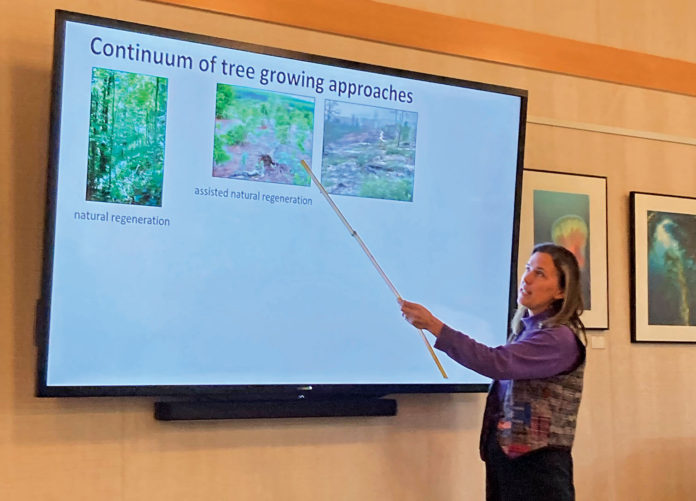
Felton resident Karen Holl’s talk at her hometown library Feb. 3 occurred just as a storm rolled in underscoring just how intrinsically linked our lives are with those of Plantae kingdom—as tree litter would soon carpet the landscape and one person would be killed when a tree came crashing down in Boulder Creek.
The UCSC professor of Environmental Studies has spent years monitoring ecosystems around the world, and she dug into that well of knowledge during her presentation titled, “Can We Save the World by Planting Trees?” in the Felton Branch Library’s community room.
“You need to start with what your goals are,” she said. “What do you hope to achieve by growing trees?”
Holl found herself in front of quite the receptive audience—locals concerned about the state of the global canopy and root networks, environmental nonprofit professionals and one person who declined to state their employment, for fear it wouldn’t sound good in the context of efforts to protect the environment.
Holl stayed in the wonky weeds the whole time, and yet it was subject matter that couldn’t be more relevant.
She spent a good chunk of the lecture enlightening a question that many locals have surely faced—how do you know which of the organizations with flashy treeplanting promises to support?
Search “help us plant trees” and a Veritree ad promises “One tree planted per sale” in the first promoted result on Google, with the first organic link reading “Plant a Billion Trees”—a path to The Nature Conservancy’s website.
Helpfully, Google notes, “People also ask…Did Mr Beast plant trees?” (It shows a teslarati.com link stating the YouTuber donated $1 million to charity and reporting that the #TeamTrees initiative planted 20 million trees by the end of 2022.)
But it’s critical to peel away the layers behind the towering words and examine what lays below the surface, says Holl, noting while some organizations are doing their best to use state-of-the-art green practices, others offer little in the way of transparency—even at a time when the landscape is flooded with carbon credit cowboys.
Every organization should have a good idea of whether it’s aiming to sequester carbon, prevent erosion and wildfires, conserve biodiversity or bloom greenspaces in urban areas, since when it comes to planting forests, it’s impossible to do everything all at once, Holl said.
“Sometimes you can get multiple benefits, but you’re not going to get all of the benefits in all cases,” she said. “The next question is whether to plant trees.”
That’s right. Sometimes the best solution for the plant is not to plant a single tree.
“One of the best ways to do it is: let nature do its work,” she said. “In a lot of cases you can get quite a bit of recovery without planting trees.”
In the tropics, for example, forests can grow naturally as animals meander their way across the face of the Earth, or as winds ruffle leaves and snap branches.
One of Holl’s own graduate students has been doing work on this very subject in the Yucatan Peninsula.
But it was the photo of one year’s worth of regrowth after the CZU Lightning Complex fires near the local UC campus that drove home the point. Around here, one of the most effective ways of growing forests is to focus on controlling invasive species, she added.
Another big factor to think about is making sure you have buy-in from stakeholders.
“You really have to engage the local communities and make sure they’re getting some benefit,” she said. “Because they need income.”
What’s the point of planting thousands of trees one year, only to have them cut for firewood or to plant crops a few years later?
The answer? Maybe that was the plan all along, in some areas, so trees could continue to flourish in other, protected, areas.
Messing up on the policy carrots can have unintended consequences. She referred to a Bloomberg Green article that covered how some Mexican residents were clearing biodiverse areas to plant trees for fruit or timber.
Holl has just published a paper about how the treeplanting world is doing.
The research didn’t name names and wasn’t a comprehensive analysis, but it did examine the websites of the various groups that raise money to add arbors.
And what she found was alarming.
Only a quarter of the organizations had measurable, time-bound objectives. Just 41% reported on the tree survival rate—which is the easiest thing to measure.
“You can see that in very few cases was there long-term funding commitments,” she said. “Only 19% discuss potential negative effects.”
Perhaps worst of all—only 1/3 displayed their financial statements.
And while most of the companies that did seem to hover around the 20% administrative cost range (a median of 80.5% going to fund treeplanting-related efforts), even this varied wildly (from 44-92%).
She praised Plant for the Planet for dropping some projects that didn’t measure up and sharpening their effectiveness.
Overall, more experienced organizations tended to get better marks in their review.
Holl said she’s been trying to get the go-ahead to dig deeper into the data.
One audience member asked why there’s no list of the better and worse performers. She said she didn’t think it was fair to put this in because they’d only looked at public-facing statements and didn’t do any case studies.
Holl has been trying to dig deeper, but her shovel has bounced back.
“We would like to do a follow-up survey,” she said. “Nobody seems to want to fund it.”
She wrote a grant proposal and sent it off to Google, suggesting she could even incorporate Google Earth into the research.
But the tech company didn’t bite—despite the fact that it recently lent employees to work on a mapping tool to help forestry officials and others navigate the landscape, as previously reported by the Press Banner.
Ellen Framer, a 71-year-old Santa Cruz resident, who is an organizer with Ecosystem Restoration Communities, definitely enjoyed the talk.
“To be honest it was going really fast—it’s a very complicated topic,” she said, noting she’s seen a lot of marketing from groups promising to make a difference by planting trees. “They really do publicize ‘we’re going to plant a million trees’ and we’re going to save everything. It seems really pie in the sky.”
Bryan Largay, a Felton resident who works at the Santa Cruz County Land Trust, said he found the presentation inspiring.
“We’ve got to get it right,” he said. “There aren’t easy answers. But there are solutions.”












